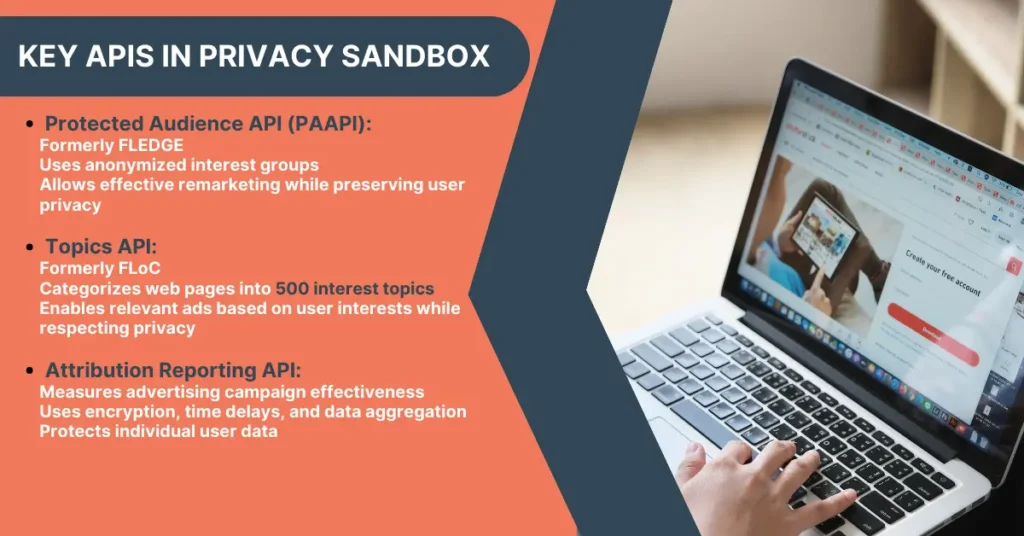In an era where privacy concerns are paramount, Google Chrome’s decision to phase out third-party cookies by 2024 has sent ripples through the digital advertising industry. This move, which comes from a browser holding a significant 63% of the global market share, signals a fundamental shift in how advertisers and publishers target and measure their online campaigns.

To address the challenges posed by the phasing out of third-party cookies, Google has introduced Privacy Sandbox—a collection of privacy-focused APIs designed to replace third-party cookies while maintaining user privacy. In this guide, we will delve into the intricacies of Privacy Sandbox, explore its key APIs, discuss its impact on advertising strategies, and provide insights into its testing and implementation.
Understanding Privacy Sandbox
Privacy Sandbox is Google’s response to the growing concerns around consumer privacy and data protection in digital advertising. It offers a set of privacy-first APIs that aim to provide a balance between personalized advertising and user privacy. These APIs are designed to enable relevant advertising, prevent fraud and spam, facilitate ad measurement and attribution, and enhance cross-site privacy.
Key APIs in Privacy Sandbox

- Protected Audience API (PAAPI): Formerly known as FLEDGE, PAAPI enables marketers to re-engage with their audiences in a privacy-preserving manner. By using anonymised and generalized audience groups called interest groups, PAAPI ensures that user privacy is maintained while still allowing for effective remarketing.
- Topics API: Previously known as Federated Learning of Cohorts (FLoC), the Topics API categorizes web pages into nearly 500 interest topics without revealing any individual user data. This enables advertisers to deliver relevant ads to users based on their interests while respecting their privacy.
- Attribution Reporting API: This API provides a way to measure the effectiveness of advertising campaigns without compromising user privacy. By using encryption, time delays, and data aggregation, it ensures that individual user data is not exposed to marketers or third parties.
Case Study: Implementing Privacy Sandbox in a Real-world Scenario
Client 1
Challenge:
A leading e-commerce company, faced a significant challenge in the wake of Google’s announcement regarding the phase-out of third-party cookies. As a company heavily reliant on digital advertising to drive sales, they needed to find a way to continue targeting their audience effectively while respecting user privacy.
Solution:
Understanding the importance of adapting to the changing landscape of digital advertising, XYZ Retail decided to embrace Google’s Privacy Sandbox. They began by exploring the various APIs offered by Privacy Sandbox and identifying how they could integrate them into their advertising strategies.
One key area where XYZ Retail saw an opportunity was in the use of the Protected Audience API (PAAPI). By leveraging PAAPI, XYZ Retail could continue to target their audience effectively while ensuring that user privacy was maintained. They also explored the Topics API to categorize their web pages into relevant interest topics, allowing for more personalized and targeted advertising.
XYZ Retail worked closely with their advertising partners and ad tech providers to ensure that their systems were updated to support the Privacy Sandbox. They also conducted extensive testing to ensure that the transition would be seamless for both their team and their customers.
Results:
By embracing Privacy Sandbox, XYZ Retail was able to maintain the effectiveness of their advertising campaigns while respecting user privacy. They saw a significant improvement in the relevance of their ads, leading to higher engagement and conversion rates.

Additionally, XYZ Retail was able to build trust with their customers by demonstrating their commitment to privacy. This resulted in a positive brand image and increased customer loyalty.
Testing and Implementation
The transition from third-party cookies to Privacy Sandbox is a significant undertaking that requires careful planning and execution. Publishers, advertisers, and ad tech platforms need to update their systems to incorporate Privacy Sandbox APIs. Google has announced plans to disable third-party cookies on 1% of Chrome traffic in Q1 2024 to assess the readiness of the ecosystem.
At Index, we recognize the importance of preparing for a cookieless solution. We have started testing the Protected Audience and Topics APIs to understand their impact and ensure that our customers and partners are well-prepared for the transition. For publishers using Prebid, we recommend updating to the latest version and enabling the necessary modules for Privacy Sandbox compatibility.
Resources for Implementation
To assist the industry in adapting to Privacy Sandbox, we have created several resources:
- Index Explains: Detailed insights into the workings of the Protected Audience API.
- Protected Audience Diagram: A technical breakdown of the PAAPI auction process.
- Protected Audience Demo: A practical demonstration of PAAPI in action.
These resources aim to provide a deeper understanding of Privacy Sandbox and its implications for digital advertising.
Frequently Asked Questions (FAQ)

Q: What is the timeline for the phase-out of third-party cookies? A: Google plans to fully phase out third-party cookies by 2024, with gradual steps leading up to this date to assess readiness and ensure a smooth transition.
Q: How will Privacy Sandbox impact advertising strategies? A: Privacy Sandbox will require advertisers to adapt their strategies to the new privacy-focused APIs. This may involve rethinking targeting and measurement approaches to align with the privacy-preserving nature of these APIs.
Q: What steps can businesses take to prepare for Privacy Sandbox? A: Businesses should start by familiarizing themselves with Privacy Sandbox and its key APIs. Testing and updating tech stacks will be essential to ensure compatibility and readiness for the transition.
Summary

Google’s Privacy Sandbox represents a significant shift in the digital advertising landscape. By offering privacy-focused alternatives to third-party cookies, Google aims to address privacy concerns while still enabling effective advertising. Advertisers and publishers need to understand these changes and prepare their strategies and systems for the cookieless future.
At Index, we are committed to helping our customers and partners navigate this transition. Our testing of Privacy Sandbox APIs and the resources we provide aim to facilitate a smooth transition to a more privacy-conscious advertising ecosystem.

Stay updated with our progress and insights as we navigate this transformation. Feel free to reach out to us for assistance or training. Together, we can adapt to this change and continue delivering effective, privacy-conscious advertising.





